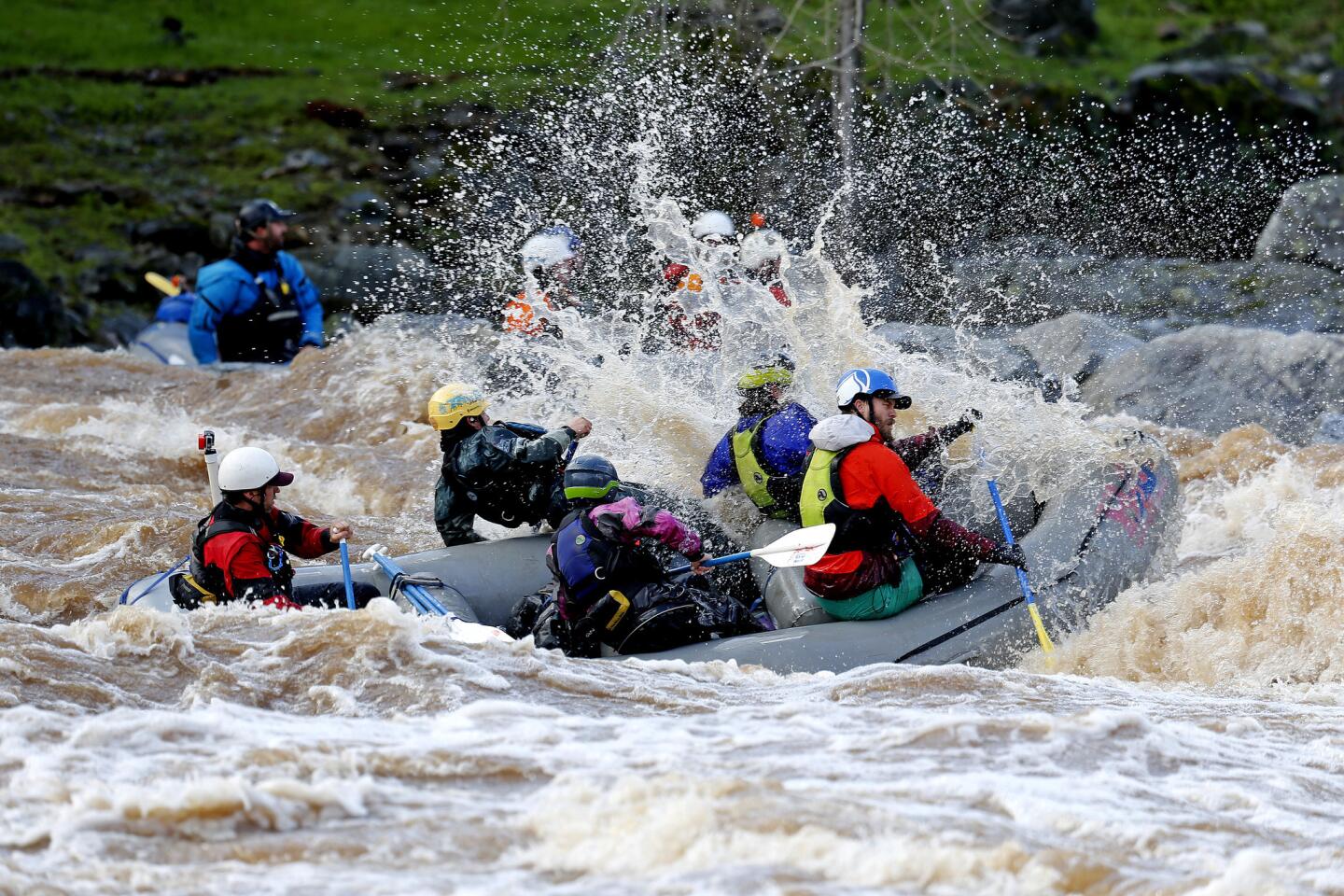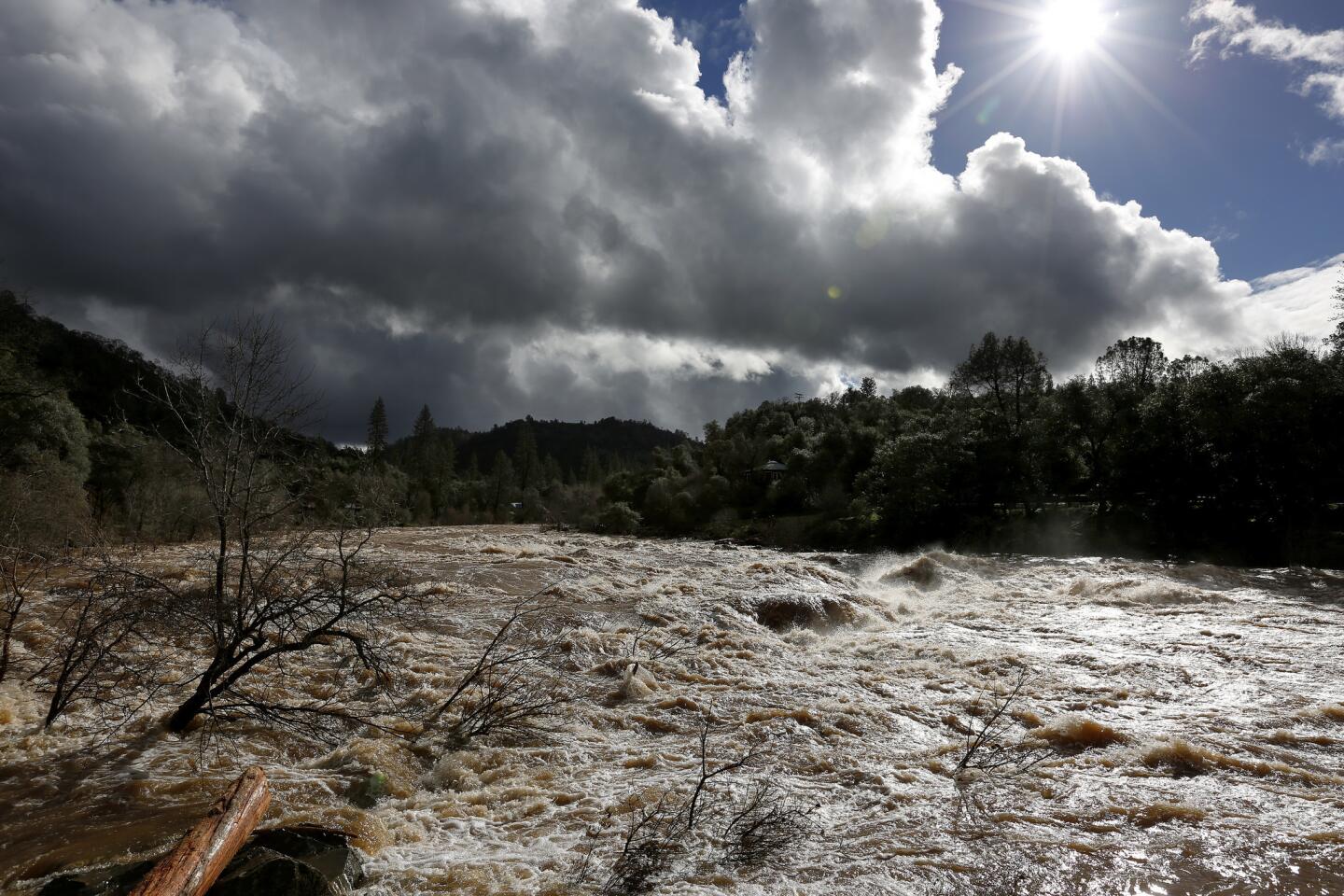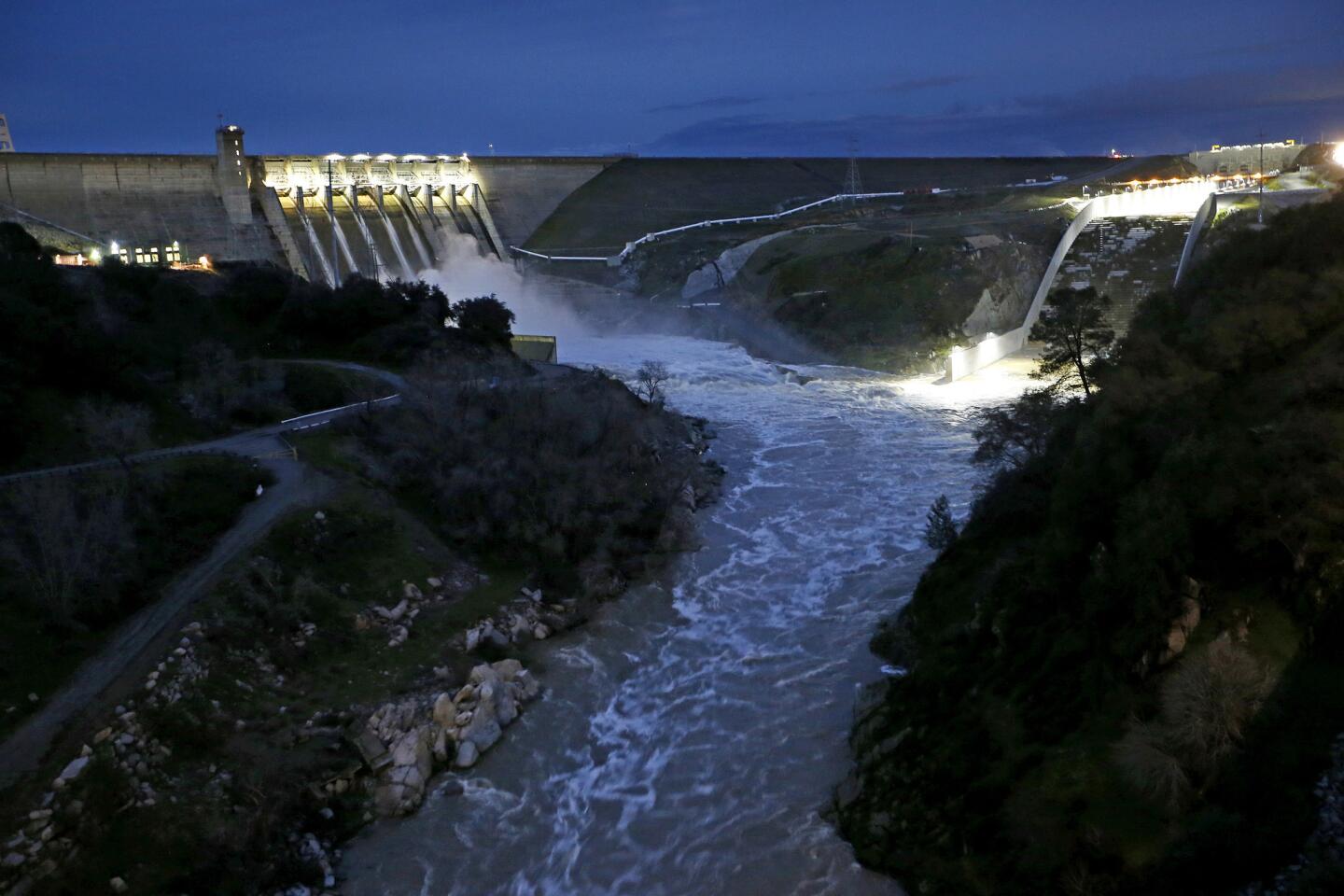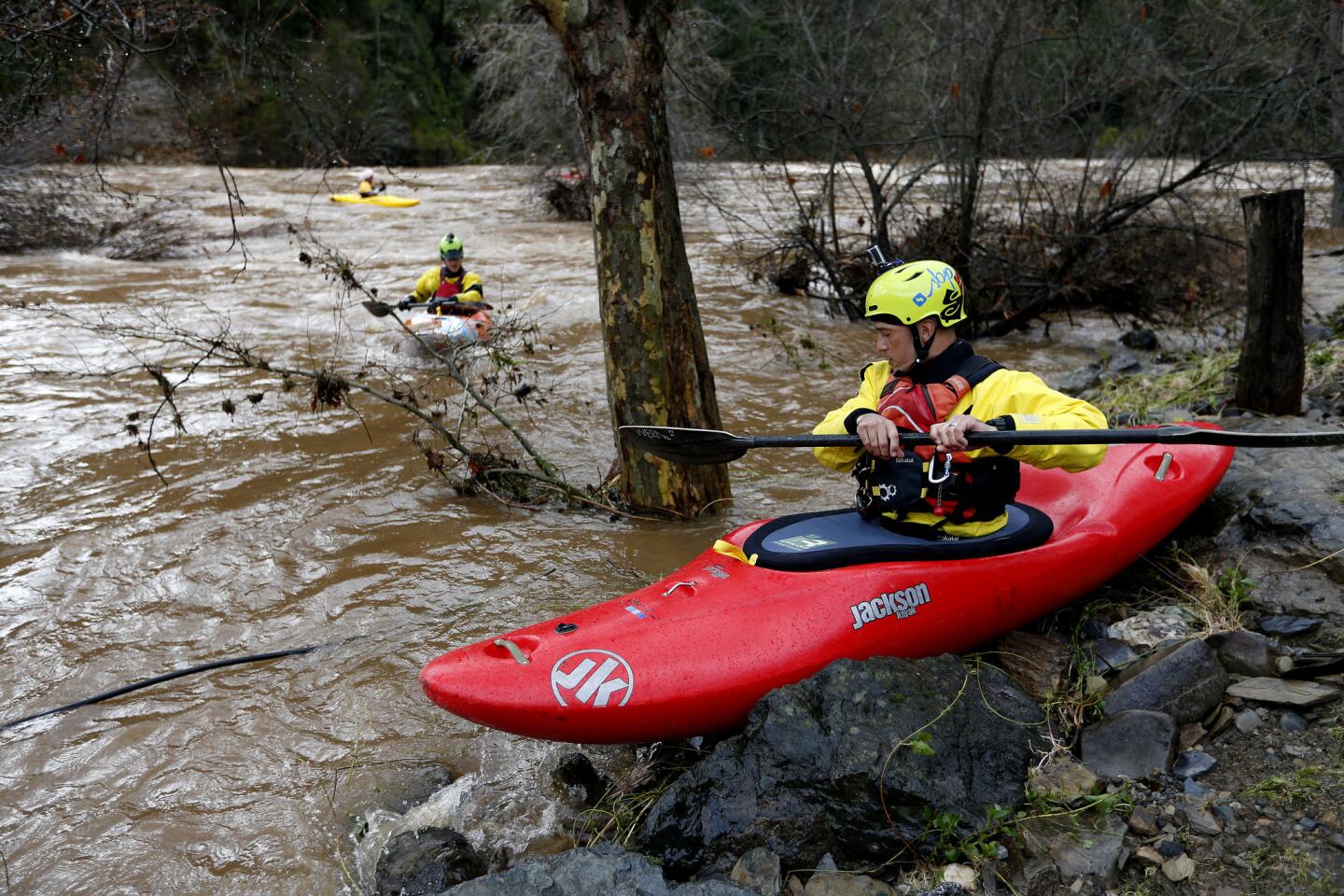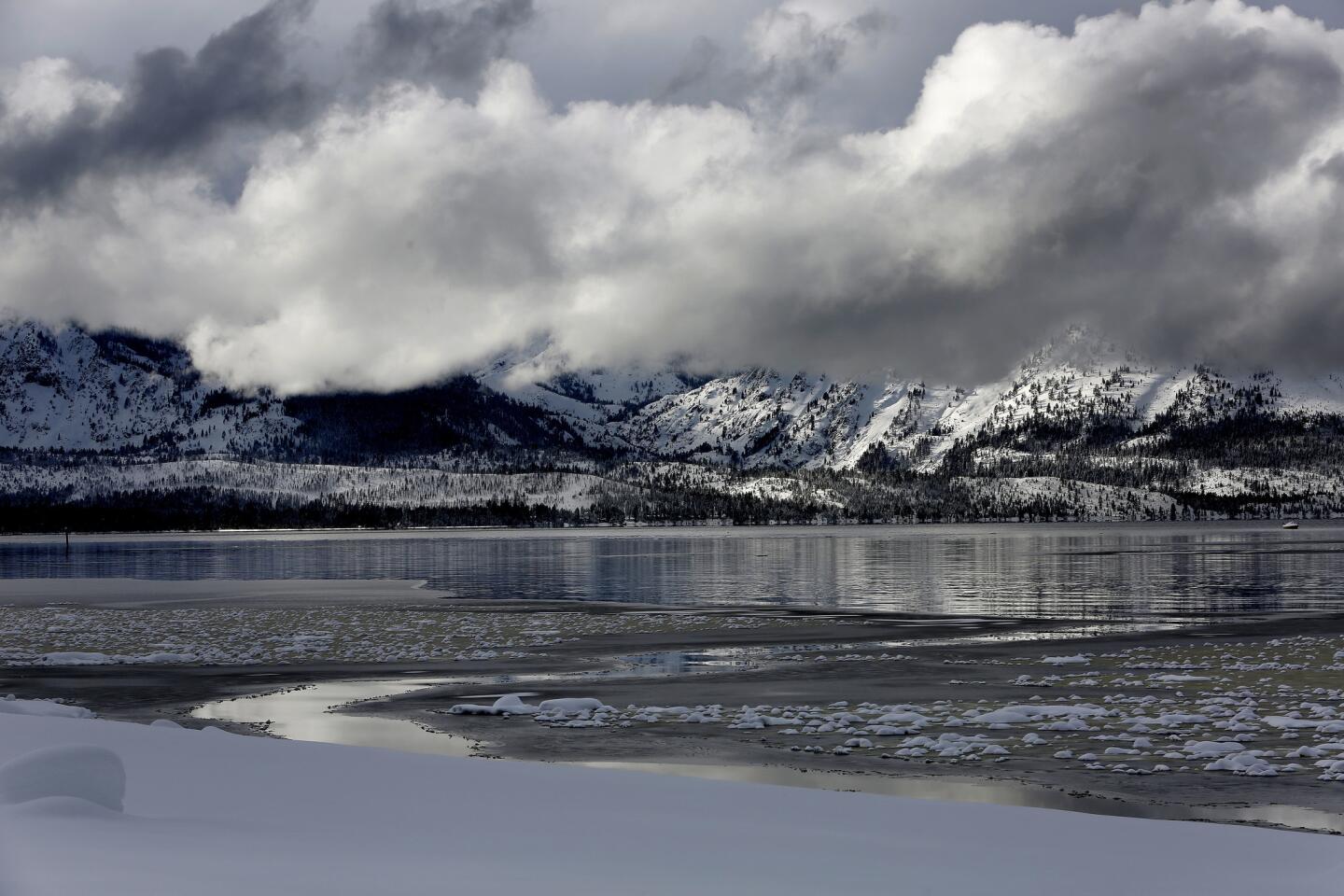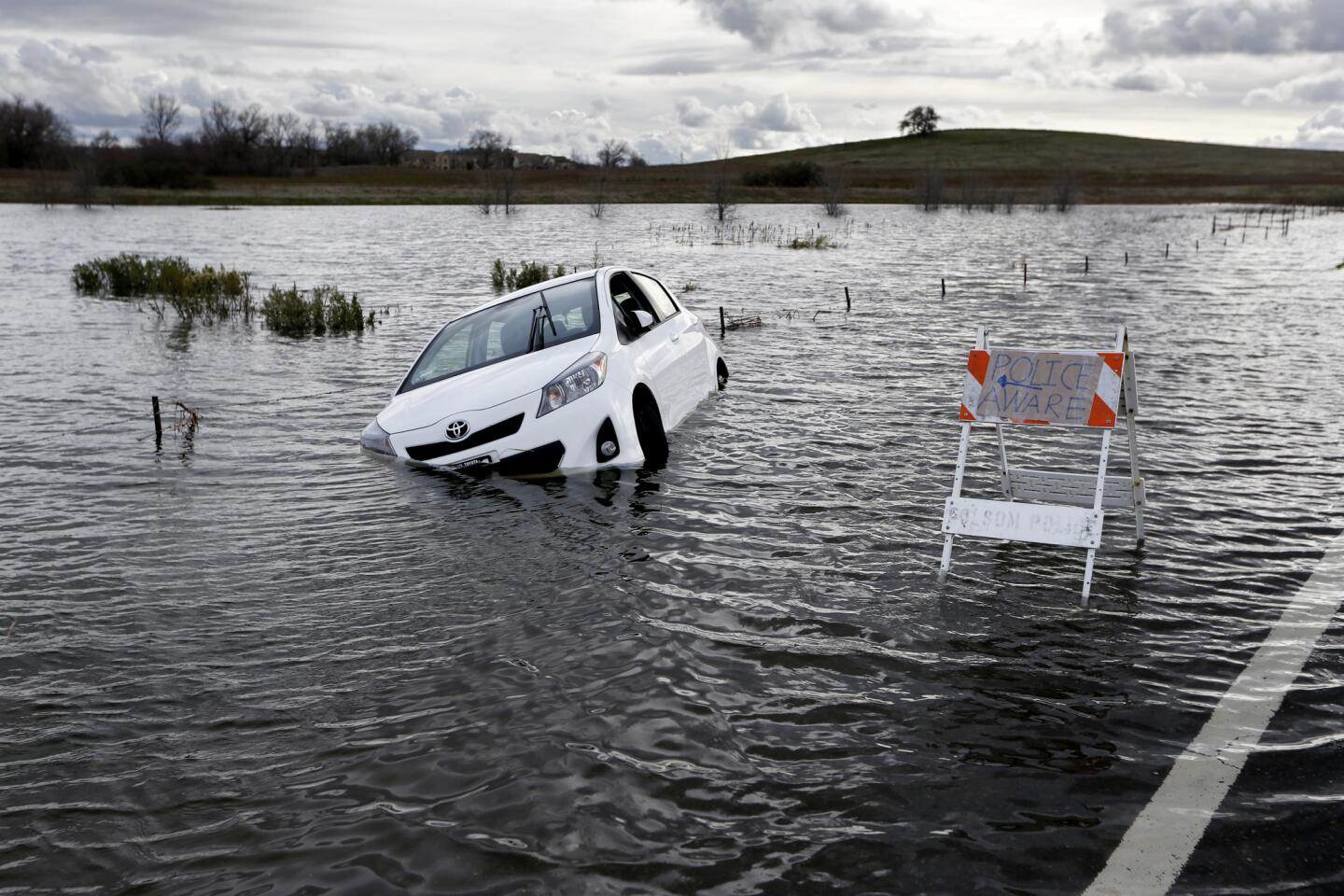From drought to deluge: How one California river tells the story of a waning drought

Storm runoff from the Sierra Nevada is filling the forks of the American River, feeding reservoirs, bedeviling flood planners and boosting kayakers’ adrenaline needs.
- Share via
Reporting from COLOMA Calif. — Torrents of meltwater coursed down the granite crevices below the moonscape of the Desolation Wilderness.
Just miles from its source in the High Sierra, the South Fork of the American River was already roaring down toward the oaken foothills, bursting over the spillways of dams that humans had erected to control it.
As it moved, it gathered streams and rivulets — pink and brown and orange from the minerals they leached. The heavy rain turned dusty creek beds into full-fledged tributaries. Running through narrowing clefts they burst forth as from hydraulic jets.
Isidro Soberanes was preparing to jump into the maelstrom in a kayak.
He stood at the Chili Bar parking lot watching the South Fork as he had never seen it. Willow trees that had sprouted in drier times now found themselves bending in a 25-mile-per-hour current, shredding the flow into rooster tails of spray. He watched a big sodden log crash at speed into underwater rocks, sending splinters flying, and race on to the next collision.
“I’ll have to watch for those,” said Soberanes, a local professional kayaker originally from Veracruz, Mexico.
“I’ve been waiting for this.”
So had so many. The boom and bust of water has always been the arid West’s existential conundrum. The biggest water projects in the world were built to control it, to allow millions of people to live in places only thousands otherwise could survive. From the Mormon settlers’ first efforts to irrigate the Salt Lake Valley to the colossal dams along the Colorado River to the vastly complex Central Valley Project that transformed California – including this river — American engineers did everything they could to keep water from escaping to the sea.
We haven’t seen water like this for 10 years, at least.
— Bob Hunden, 82
This week’s storm roaring out of a six-year drought provided an explosive reminder that, even with all that plumbing, we survive in a harsh and moody climate.
The 90-mile-long South Fork of the American River brought us to this point. When John Marshall discovered a gold flake at Sutter’s Mill in Coloma in 1848, he set off the original mass migration that would transform the West into one of the world’s great civilizations. Since then, only Herculean efforts by the mighty U.S. Bureau of Reclamation and the Army Corps of Engineers keep it from falling to ruin.
The three forks of the American River flow into Folsom Lake. Two years ago, the reservoir was at 14% capacity, so low that people could hike to the remains of a Gold Rush-era town that had been submerged when the dam was finished in 1955. Last year’s El Niño storms swallowed them up.
The storms from Monday to Wednesday brought the lake up 17 feet, approaching the brim. Every second on Wednesday afternoon, 590,000 gallons flowed in and nearly 400,000 gallons roared out of five of the dam’s spillways, twisting into the Sacramento River, on a race to the Pacific.
Water managers at the Bureau of Reclamation and the Corps of Engineers had it calculated and under control, but a belt of storms like this makes even their efforts look fickle.
For the first time in a decade, water managers opened floodgates on the Sacramento River to turn a the vast Yolo flood basin into a veritable inland sea.
“We haven’t seen water like this for 10 years, at least,” said Bob Hunden, 82, standing in the rain at Chili Bar.
He stopped by just to take in the awesome power of the river. In the way the vastness of the stars on a clear mountain night elicits that expansive feeling of being infinitesimal in the grand scheme, so can the raw power of a weather system that crossed a big swath of the planet.
The molecules in the drops falling on Hunden’s shoulders had risen as vapor thousands of miles away in the tropical heat of the central Pacific.
Condensed into a warm storm system called a Pineapple Express, it hit California and was driven upward by the Western slopes of the Sierra and Cascades. As the pressure dropped in the thinner atmosphere, the relative humidity climbed. The cold air — and high-altitude dust and microbes blown across the Pacific from deserts in Africa and China — created ice particles.
That ice started to congeal to more vapor and grow bigger and heavier and fall as snow, wringing the water out the sky.
Without that orographic lift of the High Sierra, the clouds might have just kept blowing east.
During the first storm on Sunday, the snow melted before it hit the ground, except at the highest elevations, causing fears that it would melt the snowpack and cause a catastrophic flood.
The entire water system in California and the Southwest relies on snowpack — in the Sierra, Cascades and Rockies — slowly melting in spring, at rates the reservoirs can handle.
“We like winter storms that snow down to 2,000 feet, followed by a gentle spring,” said Howard Penn, a local paddler and executive director of the Planning and Conservation League, which works to protect the state’s water, air and natural areas.
But he notes that warm winter storms also bring benefits. Decades of irrigation in the Central Valley had leached out all manner of salts and heavy metals and pesticides from the soil, and those leachates flow out with the farm runoff to pollute the Sacramento Delta, a vital breeding area for fish.
“Now we got a huge volume of water coming down the Sacramento and San Joaquin, flushing the Delta out, cleaning out those fish estuaries.”
By Wednesday, the snow level lowered in the mountains. The flakes fell heavy, not as dry Utah powder, but a wet slurry dubbed “Sierra Cement” by skiers. Avalanche danger closed ski resorts in Lake Tahoe and sections of the roads getting there from the valley. But big concerns of a ravaged snowpack diminished.
Down at Chili Bar, the mood was giddy. With a whole lot of rain hitting the lower and midslopes, the South Fork was heaving at about 150,000 gallons per second. A fun springtime trip for kayakers would run on less than a sixth of that rate.
Soberanes put on a thermal shirt, then a fleece jacket, and sealed himself into a drysuit. He kissed his wife Fernanda, and his 10-month-old daughter, Alondra, and paddled upstream through some trees in an eddy.
Fernanda got in the their old red Ford F150 and headed down Highway 49 to his takeout spot.
Soberanes knew the biggest danger was getting stuck in one of those tree thickets — “strainers” in river-runner parlance — because they catch you like a colander while the fast current pulls you under.
He moved into the 45-degree water and was soon in a section of colliding, oncoming waves that thrashed him from all directions. Cold whitewater smashed his face every other second.
He launched over massive tepees of brown water and torn up weeds, and then hit several beautiful nonbreaking waves at a rapid called Meat Grinder, one as high as 15 feet.
At this rate, he’d finish an 8-mile run that normally took an hour and a half in about 25 minutes.
Brian Kallen, a rafting guide going down the fork with friends, kept his eye on a 10-foot log floating down next to them for the first 15 minutes. If they got stuck in the trough of a stationary wave, that heavy beast could do a lot of damage, “breaching like a whale on your boat.”
Those deep stationary waves flipped many a boat, launching rafters into the roiling current without a chance to fill their lungs, then — eventually — popping them to the surface to dodge deadly strainers and hope they could scramble to shore before the onset of hypothermia.
The river Kallen knew had totally changed. Giant boulders he once passed by were now underwater and creating drops and waves he had never seen.
Soberanes moved more nimbly in his kayak, so he liked to flirt with such dangers.
Soon he was racing down a fast bumpy section, slaloming between trees, hooting along the way, like a powder skier billowing through the aspen.
He crossed under the old Coloma Bridge, then a rock monument — a good 10 feet into the river today — marking the very spot John Marshall discovered gold. The sun shone for the first time in days.
At the takeout, Fernanda, 30, sat on a blanket under some mossy oaks, cooing to her baby. The sun lit up big drops hanging from the tips of tree twigs like chandelier crystals. It suddenly felt like a picnic day in the English countryside.
She pointed to Soberanes as he rounded the bend.
“Papa viene,” she said. Daddy’s coming.
He pulled into a little eddy, still amped up on endorphins of the run, and pondered going to the next spot down the river.
“Nah, I got to get to work,” he ultimately decided. His day job is a tree-trimmer.
He’d swap his kayak for his chain saw. The wind had left him plenty of work.
ALSO
Is the great California drought finally ending?
Storm slams into Southern California, bringing flood risk, snow, mudslide warning
How California went from drought to dangerous rain and snow
More to Read
Sign up for Essential California
The most important California stories and recommendations in your inbox every morning.
You may occasionally receive promotional content from the Los Angeles Times.
